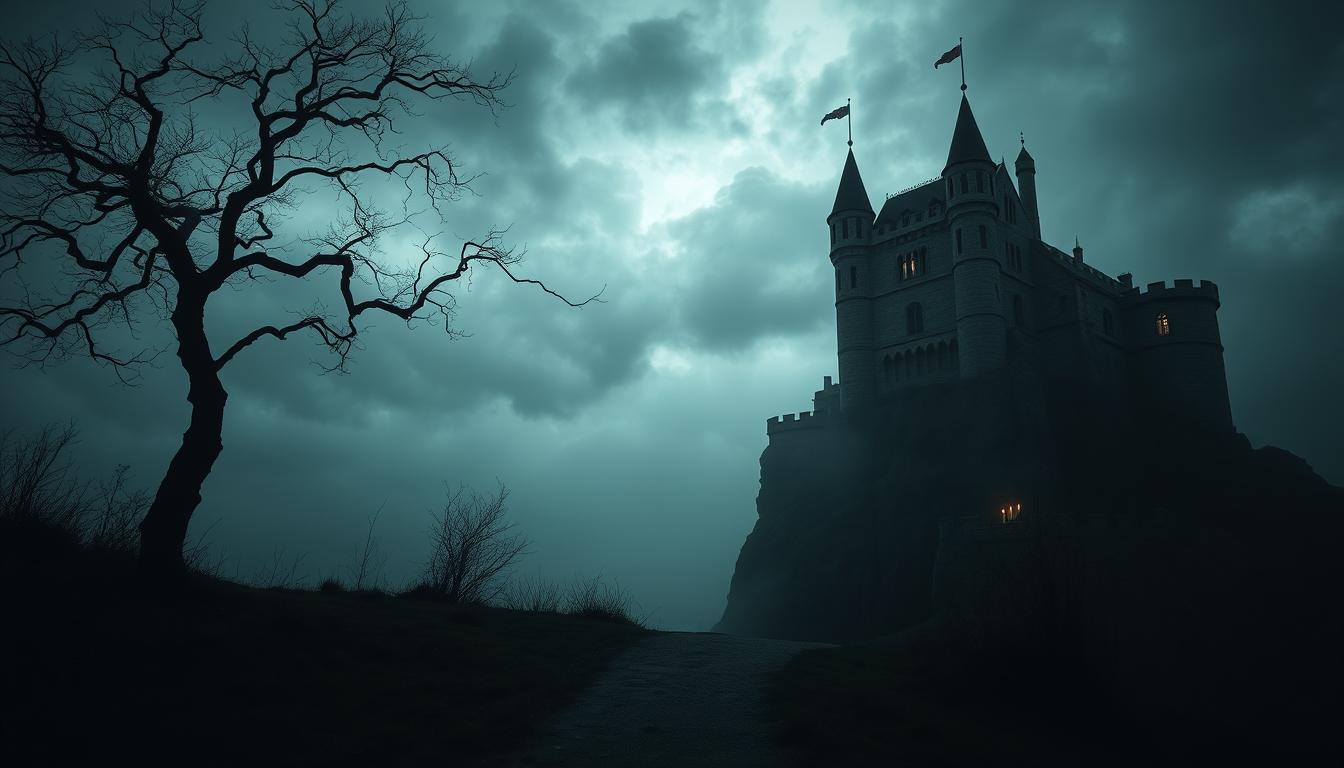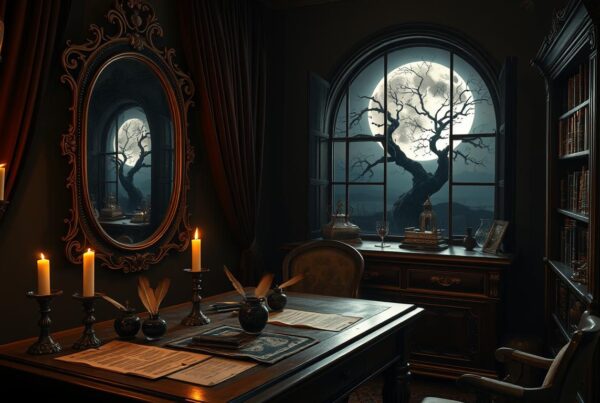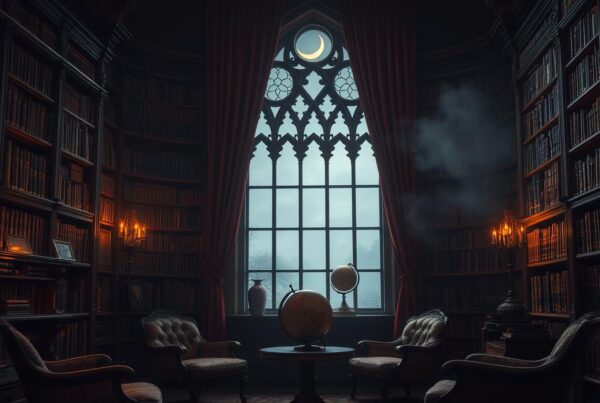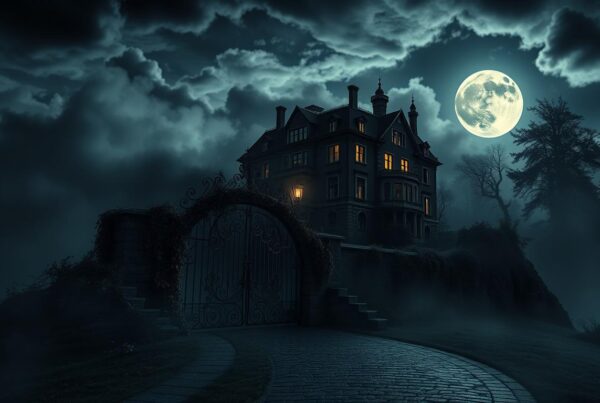Gothic romance has long captivated readers with its mix of passion and darkness. These tales weave a tapestry of love and fear. They draw us into worlds where desire and danger walk hand in hand.
In the realm of dark love stories, conflict is key. It’s the fuel that drives characters forward. They face their deepest fears and strongest longings.
Writers of Gothic fiction must master the delicate balance of tension in literature. They craft scenes that keep readers on the edge of their seats.
As we delve into the world of Gothic romance, we’ll explore what makes these tales so irresistible. From brooding heroes to haunted castles, every aspect plays a role. Get ready to unlock the secrets of conflict in writing that have enchanted readers for centuries.
The Essence of Gothic Romance
Gothic romance draws readers into a world of dark beauty and passionate love. It mixes love and fear, making stories full of mystery and charm.
Dark Atmospheres and Brooding Characters
Gothic tales are set in eerie places like haunted castles and misty moors. These settings bring out brooding heroes with secrets and complex personalities. Their stories add depth to the tales.
The Allure of Forbidden Love
Forbidden love is at the core of Gothic romance. These stories often show love that goes against the rules or faces supernatural challenges. The mix of desire and taboo keeps readers eager to see the lovers succeed.
Supernatural Elements in Gothic Fiction
The supernatural adds a thrilling twist to Gothic romance. Ghosts and curses make the love stories even more intriguing. These elements mix reality and fantasy, showing that love can conquer all.
Understanding Conflict in Storytelling
Conflict makes stories move. In Gothic romance, it shapes the story and adds tension. Writers use different kinds of conflict to grab readers and grow characters. These can be outside battles or inner struggles.
Conflict helps characters grow. When they face challenges, they learn and change. In Gothic love stories, heroes often battle forbidden love or dark secrets. These inner battles add depth and make characters real to readers.
As conflicts grow, so does the story’s tension. Gothic romances have many conflicts at once. A love story might face supernatural dangers or social rules. This mix keeps readers on edge and eager to read more.
Good stories mix different conflicts well. There might be rivalry between lovers or battles against nature. Characters might also fight their own fears or desires. By mixing these, writers craft engaging stories that draw readers in.
Creating Tension: The Art of Conflict in Gothic Love Stories
Gothic love stories live on tension. They mix internal and external conflicts to keep us hooked. Writers use personal struggles and threats to create a gripping story.
Internal vs. External Conflicts
Internal conflicts in Gothic romances often come from forbidden desires or moral dilemmas. External conflicts come from society, supernatural forces, or villains. These mix together, making the story tense and engaging.
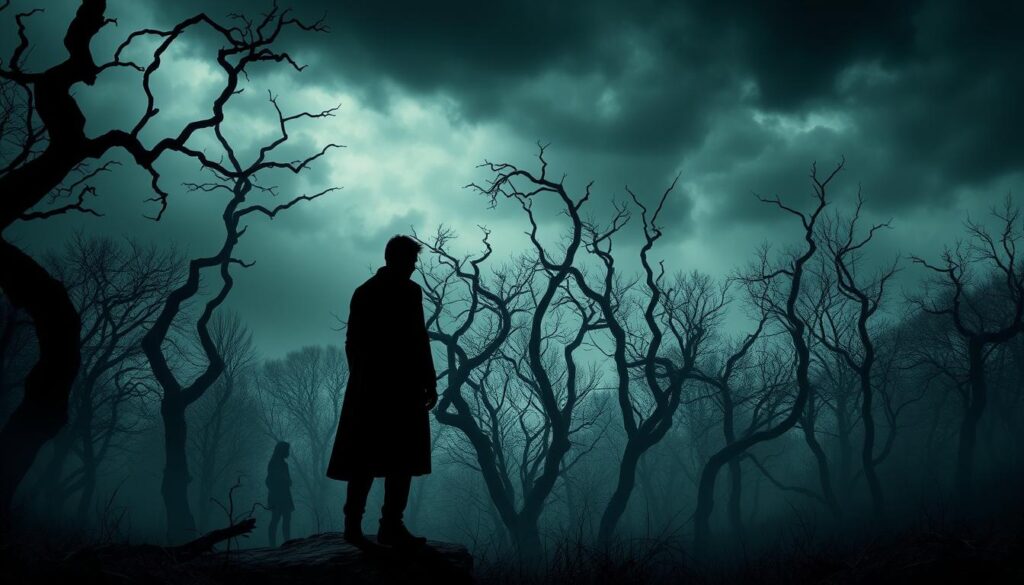
The Role of Antagonists in Gothic Romance
Antagonists in Gothic stories cause both internal and external conflicts. They might be jealous lovers, vengeful spirits, or the characters’ dark sides. These characters push the main characters to their limits, testing their love.
Balancing Love and Fear
The heart of Gothic romance is finding a balance between love and fear. Writers mix sweet moments with scary ones. This mix makes us feel more and keeps us caring about the characters.
Fear in romance makes relationships deeper. It forces characters to face their weaknesses and grow together.
Crafting Complex Characters for Gothic Romance
Gothic protagonists have a dark charm and inner struggle. They often stand between good and bad, making them complex. To make them interesting, writers need to delve deep into their characters.
Multidimensional characters are key in Gothic romances. They have mixed desires, secrets, and moral gray areas. To add depth, look into their past, current battles, and future dreams.
Gothic heroes face inner battles that reflect their outer challenges. This mix of emotions makes the story more engaging. Think about their weaknesses and strengths when creating them.
Antiheros in Gothic stories mix good and bad. They might do wrong but still win our sympathy. Give them reasons for their actions, even if they’re dark.
Remember, making characters in Gothic romance is a journey. Let them grow and show new sides as the story goes on. This keeps readers hooked on their story.
Setting the Scene: Atmospheric Tension in Gothic Literature
Gothic settings are key to creating a spooky atmosphere. The genre uses special locations and nature to make readers feel uneasy.
Haunting Locations and Their Significance
Gothic tales often take place in big castles, old mansions, or lonely places. These settings are more than just backgrounds. They shape the story and characters’ feelings.
The broken walls and dark halls of a castle show the main character’s inner struggles. This makes the fear feel real.
Weather as a Tool for Creating Unease
Weather in Gothic stories helps set the mood. Stormy nights, thick fog, and dark skies add to the tension. This is called pathetic fallacy.
Symbolism in Gothic Settings
Symbolism is big in Gothic settings. Objects and buildings often mean more than they seem. A locked room might hide secrets, and a dead garden could show decay or lost innocence.
These symbols add depth to the story, making the atmosphere even more intense.
The Power of Foreshadowing in Building Suspense
Gothic love stories live on suspense. Foreshadowing is key to making the story tense. Authors drop hints and clues to keep readers guessing.
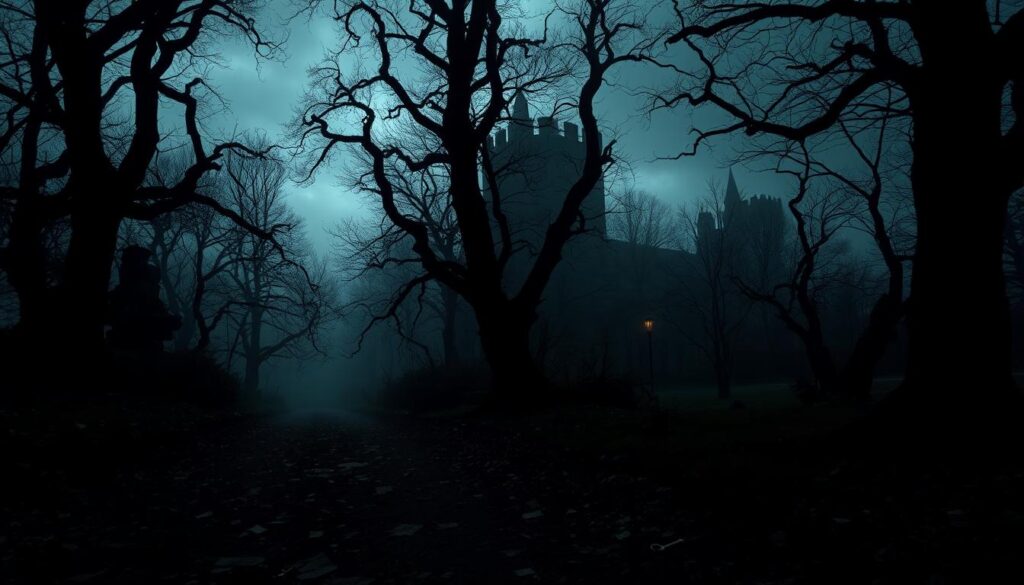
Symbolic objects or events are used in Gothic romance. A crumbling portrait might hint at a dark family past. A sudden storm could signal doom. These elements make the story tense and keep readers engaged.
Getting the balance right in foreshadowing is crucial. If it’s too obvious, you spoil the surprise. If it’s too subtle, readers might miss it. Good Gothic authors mix these hints well, rewarding readers with great payoffs.
Using foreshadowing well, writers can make Gothic love stories thrilling. The right clues and symbols build suspense. This makes the story a rich, immersive experience that stays with readers.
Dialogue Techniques to Heighten Emotional Tension
Mastering dialogue in fiction is key for emotional tension in Gothic love stories. Writers use many techniques to make character interactions exciting. This keeps readers on the edge of their seats.
Subtext and Hidden Meanings
Subtext in writing adds depth to conversations. Characters might say one thing but mean another. This leaves readers to figure out the hidden meanings.
This creates mystery and raises emotional tension between lovers in Gothic tales.
The Impact of Silence and Pauses
Silence is powerful in Gothic romance. Pauses in dialogues can build suspense and make emotions stronger. These quiet moments let readers feel the weight of unspoken words.
They also show the conflicts brewing between characters.
Contrasting Formal and Informal Speech
Gothic writers mix formal and informal speech. This highlights social differences or internal struggles. The contrast in dialogue styles adds tension and shows power dynamics in relationships.
This makes the story’s romantic elements more complex.
By using these dialogue techniques, authors can make conversations rich and layered. These conversations drive the plot and keep readers hooked in the Gothic world.
Pacing: Balancing Slow Burn and Explosive Moments
Mastering narrative pacing is key in Gothic love stories. A good story mixes slow romance and big moments. It keeps readers excited.
Slow burn romance is the heart of Gothic tales. Writers build anticipation by delaying big moments. They focus on small interactions between characters.
This makes characters deeper and emotional moments more powerful. It’s all about building up to the big scenes.
To keep readers hooked, mix slow moments with big scenes. These big moments turn the story around. They make readers want to keep reading.
It’s all about finding the right balance. Too many big moments can be too much. Too few can make the story dull.
Vary sentence length and paragraph structure to control pacing. Short sentences make action scenes fast. Long sentences slow down for deep thoughts.
This creates a rhythm that matches the story’s feelings. It’s all about controlling tension.
Effective pacing in Gothic romance is about building and releasing tension. By mastering this, writers can make stories that grab readers from the start.
Resolving Conflict in Gothic Love Stories: Satisfying Endings
The ending of Gothic love stories is a fine balance. As the climax nears, readers want a satisfying finish. This should match the dark mood they’ve grown to love.
Authors must tie up loose ends and show character growth. This makes the story feel real and rewarding.
Creating a good ending means solving main conflicts but keeping some mystery. This keeps readers hooked even after finishing the book. The story might end with lovers overcoming challenges or characters facing their fears.
The ending should show growth and change. This is key for readers to feel satisfied.
Gothic romance doesn’t need a happy ending. Sometimes, the best conclusions leave a lasting unease or bittersweet feeling. This stays true to the genre while still giving closure.
By solving conflicts and showing character growth, authors can make endings that stay with readers.
